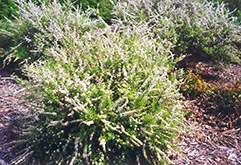Dwarf Garland Spirea
Spiraea x arguta 'Compacta'
Height: 4 feet
Spread: 3 feet
Sunlight:
![]()
Hardiness Zone: 4a
Description:
A compact ball-shaped shrub featuring gracefully arching branches smothered in striking snow-white flowers in spring, keeps tidy the rest of the year, low maintenance; beautiful in a small garden or shrub border; full sun and well-drained soil
Ornamental Features
Dwarf Garland Spirea is bathed in stunning clusters of white flowers along the branches in mid spring. It has bluish-green deciduous foliage. The small grassy leaves turn coppery-bronze in fall.
Landscape Attributes
Dwarf Garland Spirea is a multi-stemmed deciduous shrub with a more or less rounded form. Its relatively fine texture sets it apart from other landscape plants with less refined foliage.
This shrub will require occasional maintenance and upkeep, and should only be pruned after flowering to avoid removing any of the current season's flowers. It is a good choice for attracting butterflies to your yard, but is not particularly attractive to deer who tend to leave it alone in favor of tastier treats. It has no significant negative characteristics.
Dwarf Garland Spirea is recommended for the following landscape applications;
- Mass Planting
- General Garden Use
Planting & Growing
Dwarf Garland Spirea will grow to be about 4 feet tall at maturity, with a spread of 3 feet. It tends to fill out right to the ground and therefore doesn't necessarily require facer plants in front. It grows at a fast rate, and under ideal conditions can be expected to live for approximately 20 years.
This shrub should only be grown in full sunlight. It prefers to grow in average to moist conditions, and shouldn't be allowed to dry out. It is not particular as to soil type, but has a definite preference for acidic soils, and is subject to chlorosis (yellowing) of the foliage in alkaline soils. It is highly tolerant of urban pollution and will even thrive in inner city environments. This particular variety is an interspecific hybrid.
This plant may not be hardy in our region, and certain restrictions may apply. Please contact the store for further details.

